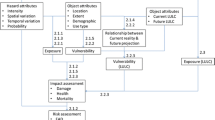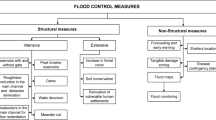Abstract
Spatially explicit hydrodynamic flood models can play animportant role in natural hazard risk reduction. A key element of these models that make them suitable for riskreduction is the ability to provide time-series inundation information about the onset, duration and passingof a hazard event. Such information can be critical for landuse planning, for mapping evacuation egress routes,and for locating suitable emergency shelters to name only a few risk treatments. This research contends that abarrier to effective risk reduction is providing disaster managers with access to model results in a structured andflexible framework that allows consequences of different hazard scenarios to be assessed and mapped. Toaddress these limitations, a framework has been developed that links a commercial relational databasemanagement system with a GIS-based decision support system. The framework utilises industry standard dataexchange protocols and results in efficient time-series hazard data management. A case study based in Cairns,in far-north coastal Australia is presented to illustrate how the system has been developed. Results show that theframework reduces data volumes significantly, while making pre-run modelled inundation results rapidly accessibleto disaster managers. Of note is the ability of the framework to present results in terms of risk to buildings,roads and other spatial features in urban regions, and to provide answers to relatively complex risk questions.
Similar content being viewed by others
References
Australian Geological Survey Organisation: 2002, Tropical Cyclones: Hazard Modelling and Risk Assessment(http://www.agso.gov.au/pdf/UC0008.pdf). Last accessed April 22nd, 2002.
Bates, P. D. and De Roo, A. P. J.: 2000, A simple raster-based model for flood inundation simulation, Journal of Hydrology 236, 54–57.
Biza, P., Gimun, V., Knap, R., Ammentorp, H. C., Ihly, T., and Smith, G.: 2001, The use of a GISbased software tool for benefit-cost analysis of flood mitigation measures in the Czech Republic, DHI Software Conference, June 2001.
Brisbane City Council: 2002, Flood regulation lines, (http://www.brisbane.qld.gov.au/council_at_work/environment/improving_waterways/flood_management/flood_regulation_lines.shtml). Last accessed May 7th, 2002.
Clark, M.: 1998, Putting water in its place: A perspective on GIS in hydrology and water management, Hydrological Processes 12, 823-834.
Colby, J. D., Mulcahy, K. A., and Wang, Y.: 2000, Modelling flooding extent from Hurricane Floyd in the coastal plains of North Carolina, Environmental Hazards 2, 157–168.
Correia, F. N., Saraiva, M. D. Da Silva, F. N., and Ramos, I.: 1999, Floodplain management in urban developing areas. Part II. GIS-based flood analysis and urban growth modelling, Water Resources Management 13, 23–37.
DHI Water and Environment: 2000, Mike21, Danish Hydraulic Instiutte, Horsholm, Denmark.
Di Mauro, C., Nordvik, J. P., and Lucia, 2002, Multi-criteria decision support system and data warehouse for designing and monitoring sustainable industrial strategies an Italian case study. IEMMSs Conference, Lugano, Switzerland, pp. 216–221.
Dutta, D., Herath, S., and Musiake, K.: 2000, Flood inundation simulation in a river basin using a physically based distributed hydrologic model, Hydrological Processes 14, 497–519.
EPA: 2002, Queensland State Coastal Management Plan, Queensland Environmental Protection Agency, Brisbane, Australia, 87 pp.
ESRI: 2001, ArcView3.2 GIS, Environmental Systems Research Institute, Redlands, CA.
Fedra, K.: 1993, Models, GIS and expert systems: Integrated water resources models, HidroGIS'93: Application of Geographic Information System in Hydrology and Water Resources, Proceedings, IAHS Publ. No. 211, Vienna, Austria.
Granger, K.: 1993, Understanding Queensland's storm tide hazards, AURISA 93, Adelaide, AURISA.
Granger, K. J. and Smith, D. I.: 1995, Storm tide impact and consequence modelling: Some preliminary observations, Mathematical and Computer Modelling 21(9), 15–21.
Harper, B.: 1998, Storm tide threat in Queensland: History, prediction and relative risk, Department of Environment and Heritage Report, Brisbane, Queensland.
Hutchinson, M.: 1996, ANUDEM, Canberra, Centre for Resource and Environmental Studies, Australian National University.
Hubbert, G. D. and McInnes, K. L.: 1999a, A storm surge inundation model for coastal planning and impact studies, Journal of Coastal Research 915(1), 168–185.
Hubbert, G. D. and McInnes, K. L.: 1999b, Modelling storm surges and coastal ocean flooding, Modelling Coastal Sea Processes, B. J. Noye, World Scientific Publishing Co., pp. 159–188.
Jain, S. K., Singh, R. D., and Seth, S. M.: 2000, Design flood estimation using GIS supported GIUH approach, Water Resources Management 14, pp. 369–376.
Lanza, L. and Siccardi, F.: 1995, The role of GIS as a tool for the assessment of flood hazard at the regional scale, In: A. Carrara and F. Guzzetti (eds), Geographical Information Systems in Assessing Natural Hazards, Vol. 6, Kluwer Academic, Dordrecht, pp. 199–217.
McInnes, K. L., Walsh, K. J. E., and Pittock, A. B.: 2000, Impact of sea level rise and storm surges on coastal resorts: Final report. A project for CSIRO Tourism Research. 22 pp.
McInnes, K. L, Walsh, K. J. E., Hubbert, G. D., and Beer, T.: 2003, Impact of sea level rise and storm surges on a coastal community, Natural Hazards 30, 187–207.
Noman, N. S., Nelson, E. J., and Zundel, A. K.: 2001, Review of automated floodplain delineation from digital terrain models, Journal of Water Resources Planning and Management 6, 394–402.
Nott, J. and Hayne: 2001, High frequency of ‘super-cyclones’ along the Great Barrier Reef over the past 5,000 years, Nature 413, 508–512.
Nunes, F., Castro, F., Da Graca, M., and Ramos, I.: 1998, Coupling GIS with hydrologic and hydraulic flood modelling, Water Resources Management 12, 229–249.
OGC: 2002, Open GIS consortium (http://www.opengis.org/). Last accessed October 4, 2002.
Pickup, G. and Marks, A.: 2001, Identification of Floodplains and Estimation of Floodplain Flow Velocities for Sediment Transport Modelling, CSIRO Land & Water, Technical Report 10/01, July 2001, 26 pp.
Richmond Valley Council: 2002, Richmond Valley Council: Casino floodplain management study and plan (http://www.richmondvalley.nsw.gov.au/works/). Last accessed May 2nd, 2002.
Sanchez-Marre,M., Gibert, K., Rodriguez-Roda, I., Bueno, E., Mozo, L., Clavell, A., Martin, M., and Rouge. P.: 2002, Development of an intelligent data analysis system for knowledge management in environmental databases, iEMMSs, Lugano Switzerland, pp. 421–425.
Sanderson, B., Ming Tang, Y., Holland, G., Grimshaw, R., and Woodcock, F.: 1995, A Tropical Cyclone Maximum Envelope of Waters (MEOW) Technique, Bureau of Meteorology Research Centre, Melbourne.
Seder, I., Weinkauf, R., and Seder, I.: 2000, Knowledge-based databases and intelligent decision support for environmental management in urban systems, Computers, Environment and Urban Systems 24, 233–350.
Todini, E.: 1999, An operational decision support system for flood risk mapping, forecasting and management, Urban Water 1, 131–143.
Townsend, P. A. and Walsh, S. J.: 1998, Modeling floodplain inundation using integrated GIS with radar and optical remote sensing, Geomorphology 21, 295–312.
Vermeiren, J. C. and Watson, C. C.: 1994, New technology for improved storm risk assessment in the Caribbean, Disaster Management 6(4), 191–196.
Werner, M. G. F.: 2001, Impact of grid size on GIS based flood extent mapping using a 1D flow model, Physical Chemical Earth (B) 26(7–8) 517–522.
Zerger, A.: 1996, Application of spatial analysis and GIS for modelling risk in storm surge prone areas of Northern Queensland, Natural Disaster Reduction 1996, Surfers Paradise, Queensland, Institute of Engineers, pp. 99–105.
Zerger, A.: 1999, Digital elevation modelling for natural hazard risk assessment, Australian Journal of Emergency Management 13(4), 61–65.
Zerger, A.: 2002, Examining GIS decision utility for natural hazard risk modelling, Environmental Modelling and Software 17, 287–294.
Author information
Authors and Affiliations
Rights and permissions
About this article
Cite this article
Zerger, A., Wealands, S. Beyond Modelling: Linking Models with GIS for Flood Risk Management. Natural Hazards 33, 191–208 (2004). https://doi.org/10.1023/B:NHAZ.0000037040.72866.92
Issue Date:
DOI: https://doi.org/10.1023/B:NHAZ.0000037040.72866.92




